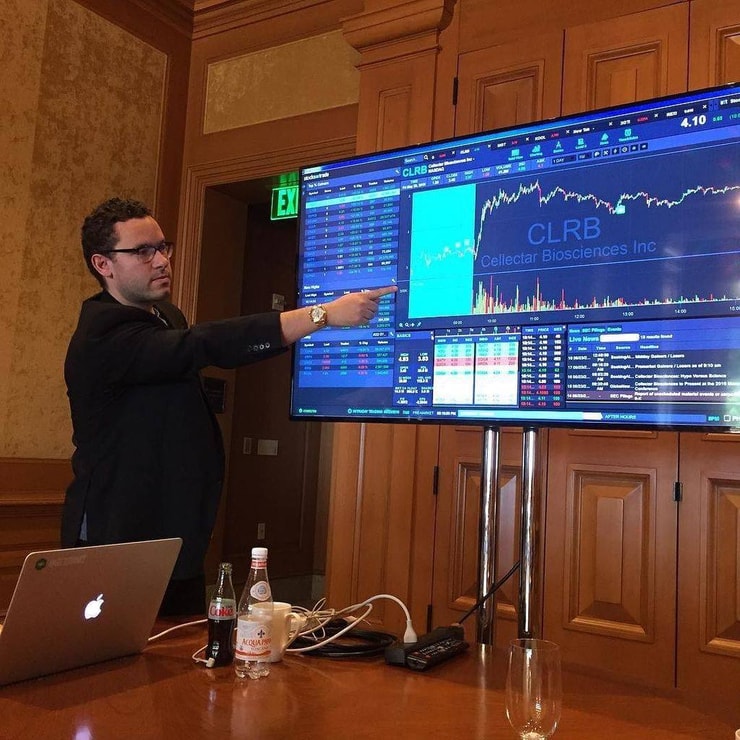Day trading is a unique form of trading where traders buy and sell securities within a single trading day. The goal is to profit from short-term price fluctuations in the market. It requires a thorough understanding of the market, experience with day trading strategies, and skills with the proper tools and services to research and trade the latest moves.
Day traders, unlike traditional investors, aren’t looking for long-term investments. But they do need to have a long-term strategy.
Sounds confusing? It doesn’t have to be.
As someone who’s made money over 20-plus years of day trading, I’ve got experience and tips for how to get started day trading. This article will talk about the work you need to put in, the techniques you need in place, and give you some examples…
Are you ready to day trade? Let’s get started!
Table of Contents
What Is Day Trading?

Day trading is a strategy that involves buying and selling securities within the same trading day. The objective is to capitalize on small price movements of highly liquid stocks, exchange-traded funds (ETFs), or other investment products. It’s a practice that requires focus, quick decision-making, and a deep understanding of the market.
Day traders use a variety of strategies to navigate the stock market, including range trading, momentum trading, and news-based trading. Each strategy requires a different set of skills and information, and each carries its own risks and rewards.
To truly excel in day trading, one must immerse themselves in the world of trading and its many facets. To get a comprehensive understanding, our article on Day Trading is a must-read. It provides a detailed overview of day trading, its strategies, and the mindset required to succeed in it. So, why wait? Dive into the world of day trading now!
Advantages of Day Trading
Day trading can be lucrative, but it’s not for everyone. It requires a significant time investment, as you’ll need to monitor the markets and your positions throughout the day. However, for those who master it, the potential rewards are enticing. One of the main advantages of day trading is the potential for quick profits. Since day traders capitalize on short-term price fluctuations, they can make a profit within a single trading day. Additionally, day trading allows for greater leverage, which can amplify profits. However, it’s important to remember that leverage can also amplify losses.
Types of Day Trades
Day trading is not a one-size-fits-all practice. There are several types of day trades, each with its own set of strategies and risks. Understanding these can help you decide which one aligns best with your risk tolerance and trading goals.
Check out this article on Day Trading Basics before reading any further…
It serves as a comprehensive guide for beginners, covering everything from the definition of day trading to the skills required to succeed in it. It’s an essential read for anyone looking to venture into the world of day trading.
Pattern Day Trader
A Pattern Day Trader (PDT) is a trader who executes four or more day trades within five business days in a margin account, provided the number of day trades is more than six percent of the customer’s total trading activity for that same five-day period.
You’ll hear the term most often in terms of the limit put on it — the Pattern Day Trader Rule. This rule stops those with less than $25,000 in savings and investment products in their brokerage accounts from making more than three day trades a week…
To help you navigate these rules, we have an article on Pattern Day Trader Rules that provides a detailed explanation of these regulations and how to navigate them.
However, if you’re trading shares with different brokers, you’re able to multiply your order limit!
More Breaking News
- Why is Sangamo Therapeutics’ Stock Volatile? Unraveling the Forecasts
- Denison Mines Corp Stock: Is It On The Edge Of A Boom Or A Bust?
- Canopy Growth’s Latest Moves: Are Shares Set to Take Off or Crash?
Range Trading

Range trading is a strategy that involves trading a security within a specific price range. Traders identify the range by pinpointing areas of support and resistance. The goal is to buy at the low end of the range and sell at the high end.
Momentum Trading
Momentum trading is a technique where traders buy and sell securities according to the strength of recent price trends. In this strategy, traders bet that an asset price that has been trending up or down will continue to do so. It requires a solid understanding of technical analysis and a keen eye for market trends.
High-Frequency Trading
High-frequency trading (HFT) is a more advanced form of trading that uses powerful computers to transact a large number of trades in fractions of a second. It’s based on complex algorithms and is typically used by large investment firms.
HFT can be profitable, but it’s not typically a viable strategy for individual traders due to the technological and financial resources required.
News-Based Trading
News-based trading involves making trading decisions based on news events. Traders capitalize on the volatility that news events create in the market.
This could be anything from a change in government policy to a company’s quarterly earnings report. It’s a strategy that requires staying on top of current events and understanding how these events affect the market.
Risks Involved in Day Trading
Day trading is not without its risks. It’s a high-risk strategy that can lead to significant losses. Understanding these risks is crucial before you dive in.
Risk Tolerance
Every trader has a different level of risk tolerance. Some are comfortable with high-risk, high-reward strategies, while others prefer to play it safe. It’s essential to understand your own risk tolerance before you start day trading. Remember, never risk more than you can afford to lose.
Technical Analysis for Risk Mitigation
Technical analysis can help mitigate some of the risks involved in day trading. It involves analyzing statistical trends gathered from trading activity, such as price movement and volume. While it’s not a foolproof method, it can provide valuable insights into market trends and potential trading opportunities.
Requirements for Becoming a Day Trader

Becoming a successful day trader requires more than just a knack for picking winning trades. There are certain requirements you’ll need to meet.
Minimum Equity Requirement
To be a Pattern Day Trader, you’ll need a minimum equity of $25,000 in your trading account. This requirement is set by the Financial Industry Regulatory Authority (FINRA) to ensure traders can absorb potential losses.
Brokerage Firms and Investment Firms
Choosing the right brokerage firm is crucial. You’ll want a broker that offers low commissions, advanced trading platforms, and quality research. Some traders may also choose to work with investment firms, which can provide additional resources and support.
What Does a Day Trader Do?
A day trader, simply put, buys and sells securities within the same trading day. The goal is to profit from short-term price movements in the market. A typical day in the life of a day trader involves a lot of research, analysis, and quick decision-making. They monitor the markets, analyze trends, make trades, and manage their portfolio. It’s a high-stress job that requires focus, discipline, and a deep understanding of the market.
Strategies to Become a Successful Day Trader

Becoming a successful day trader requires more than just a basic understanding of the market. It requires a solid strategy, a deep understanding of various trading techniques, and a disciplined approach to risk management.
Conduct Self-Assessment
Before you start day trading, it’s important to conduct a self-assessment. Understand your financial goals, your risk tolerance, and your commitment level. Day trading requires time, effort, and a significant amount of risk. Make sure it aligns with your personal and financial goals.
Make Way for Sufficient Capital
Day trading requires capital. The more capital you have, the more flexibility you have in your trading. But remember, you should only trade with money you can afford to lose.
Understand the Market Well
Understanding the market is crucial for day trading. You need to understand how market trends work, how to analyze market data, and how to make informed trading decisions. This requires a lot of research and ongoing learning.
Understand Securities
Securities are financial instruments like stocks, bonds, or options that you can buy or sell in the market. Each type of security has its own set of characteristics, risks, and ways to trade. Understanding these can help you make informed trading decisions.
Prepare a Trading Strategy

A trading strategy is a fixed plan designed to achieve a profitable return by going long or short in markets. It should be based on investment objectives, risk tolerance, and individual preferences. The key components of a trading strategy are the markets to trade, trade setups, entry points, exit points, and money management rules.
Implement Strategy and Planning
Once you have a trading strategy, the next step is to implement it. This involves placing trades based on your strategy, monitoring your trades, and making adjustments as necessary. It’s important to stick to your plan and not let emotions drive your trading decisions.
Ensure Money Management
Money management is an essential aspect of day trading. It involves setting stop-loss orders to limit potential losses, diversifying your portfolio to spread risk, and reinvesting profits to compound gains. Good money management can help you protect your trading capital and increase your profitability.
Research Brokerage Charges
Brokerage charges can eat into your profits, so it’s important to understand them before you start trading. These can include trading fees, account fees, and margin rates. Some brokers offer lower fees for higher-volume traders, so it’s worth shopping around to find the best deal.
Simulate and Backtest
Before you start trading with real money, it’s a good idea to simulate and backtest your trading strategy. Many trading platforms offer simulation tools that allow you to trade with virtual money. Backtesting involves testing your trading strategy on historical market data to see how it would have performed.
Start Small and Expand
When you’re first starting out, it’s a good idea to start small. This can help you get a feel for the market and learn from your mistakes without risking too much money. As you gain experience and confidence, you can gradually increase the size of your trades.
Day Trading Risk Management

Risk management is crucial in day trading. It involves identifying, assessing, and taking measures to reduce risk. This can include setting stop-loss orders to limit potential losses, diversifying your portfolio to spread risk, and only using money you can afford to lose for trading. It’s also important to regularly review your trading performance and make adjustments to your strategy as necessary.
Is Day Trading Right for You?
Day trading is not for everyone. It requires a significant time commitment, as you need to monitor the markets throughout the trading day. It also involves a high level of risk and can result in financial loss. However, for those who are willing to put in the time and effort to learn the ins and outs of the market, develop a solid trading strategy, and stick to their trading plan, day trading can be a profitable venture.
Key Takeaways

Day trading involves buying and selling securities within a single trading day with the goal of profiting from short-term price movements. It requires a deep understanding of the market, a solid trading strategy, and a high tolerance for risk. While it can be profitable, it’s not for everyone and involves a significant amount of risk. Before you start day trading, it’s important to educate yourself, develop a trading plan, and practice good risk management.
Trading isn’t rocket science. It’s a skill you build and work on like any other. Trading has changed my life, and I think this way of life should be open to more people…
I’ve built my Trading Challenge to pass on the things I had to learn for myself. It’s the kind of community that I wish I had when I was starting out.
We don’t accept everyone. If you’re up for the challenge — I want to hear from you.
Apply to the Trading Challenge here.
Trading is a battlefield. The more knowledge you have, the better prepared you’ll be.
Do you day trade? Let me know in the comments — I love hearing from my readers!





Leave a reply